
- DTV Headend Equipment
-
Control Room Console
- Custom Tables & Desks
-
AM Transmitters
- AM (SW, MW) Antennas
- FM Broadcast Transmitters
- FM Broadcast Antennas
-
Broadcast Towers
- STL Links
- Full Packages
- On-Air Studio
- Cable and Accssories
- Passive Equipment
- Transmitter Combiners
- RF Cavity Filters
- RF Hybrid Couplers
- Fiber Optic Products
-
TV Transmitters
-
TV Station Antennas
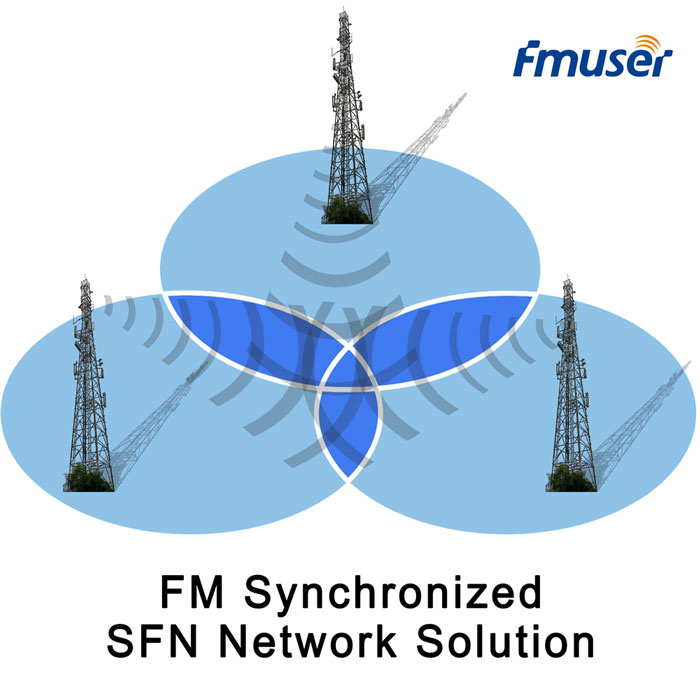
FMUSER Single-Frequency Network Complete SFN Network Solution
FEATURES
- Price (USD): Ask for a Quotation
- Qty (PCS): 1
- Shipping (USD): Ask for a Quotation
- Total (USD): Ask for a Quotation
- Shipping Method: DHL, FedEx, UPS, EMS, By Sea, By Air
- Payment: TT(Bank Transfer), Western Union, Paypal, Payoneer
FM Single-Frequency Network (SFN Network) is a digital broadcasting system that utilizes multiple radio transmitters working together to broadcast the same signal simultaneously on a single radio frequency. This system helps to enhance radio reception by using a number of transmitters to send the same signal instead of just one. The signals are synchronized with each other to provide a stronger, more reliable signal at the receiver’s end. This system also helps in reducing interference from other stations and to provide better coverage in hard to reach areas.
Complete FM Single-Frequency Network (SFN Network) Solution from FMUSER
Our solution can be defined as a "networked" project, which consists of three networks, namely:
- FM Single Frequency Network (FM SFN Network)
- Audio Sync Transmission Network
- Remote Monitoring and Management Network.
These solutions can be simply deployed in an efficient manner, and can seamlessly syncronize FM radio signals in a wide coverage with following equipment:
- SFN FM Transmitter
- Sync Audio Encoder
- Sync Audio Decoder
- GPS Standard Frequency Generator
- Digital Standard Frequency Generator
- Sync Digital Audio Satellite Receiver
- GPS antenna (GNSS)
- Data Telemetry Controller for FM Transmitters
- Complete Management System (Software)
FMUSER SFN Network Solutions Explained
In order for the best quality of the SFN network construction, here are some keypoints you should bear in mind:
- Optimzing the Effective Radiated Power (EPR) of the SFN transmitters of each base station, always keep it under 20% to ERP of the main SFN transmitter.
- Maintaining the stability of the delay difference for the audio transmission channel.
- Mataining the stability and high precision for the GPS.
- Adopting high-quality FSN transmitter
Here are 4 main solutions from FMUSER:
Most Professional: Satellite-based FM SFN Network Solution
This solution is best for continent-level or county level broadcasting. However, to start with this solution, a satellite transmitter is needed for the broadcast station, or the audio signals might not be transmitted to mutiple sync transmitting sites.
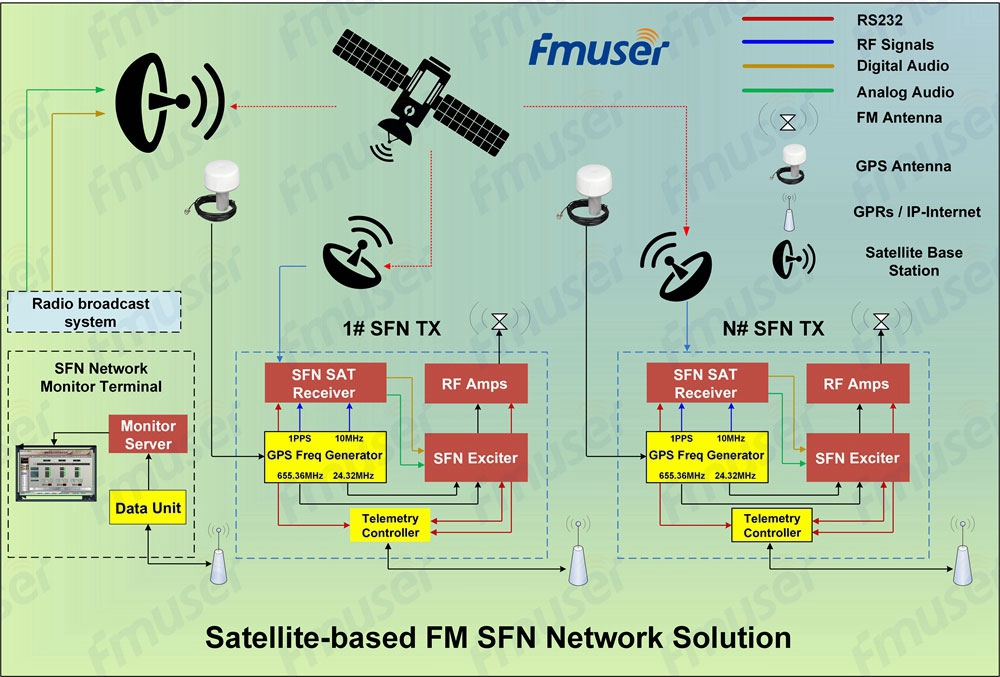
Winner's Choice: Cable-based FM SFN Network Solution
This solution is best for region-level or city-level broadcasting. It works by transmitting audio signals that is sync-encoded to cable TV front end with the help of hybrid fiber-coaxial (HFC) network constructed by local governement, then be transmitted by the sync-decoder of the end-users, the audio signals will finally be transmitted to the multiple transmitters on the sync base stations. By using the existing HFC network for SFN network building, the broadcasters are able to greatly save their investment.
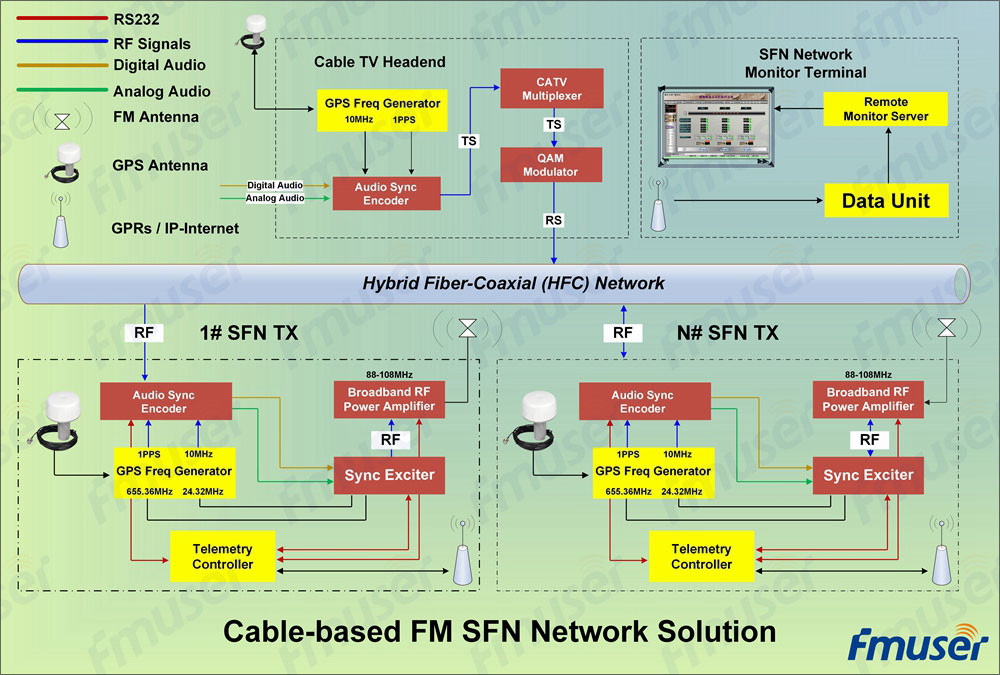
Win-Win Choice: Fiber-based FM SFN Network Solution
This solution is famous for Synchronous Digital Hierarchy (SDH), and is best for price-performance. With the advantages of wide transmission bandwidth, high transmission volume, long transmission distance, and hardly suffer from electromagnetic interferences, the fiber-based solution allows the radio stations to transmit audio signals to the multiple transmitters on the sync base stations via the existing SDH network.
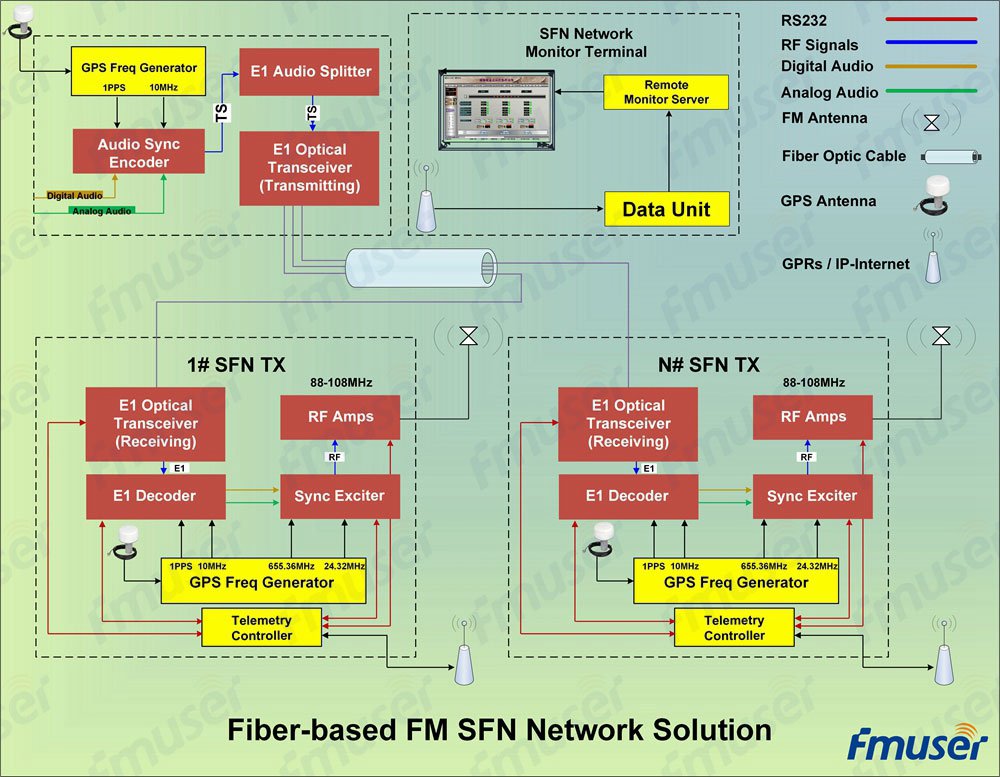
Classic Choice: Microwave-based FM SFN Network Solution
In different regions around the world, there are widely different natural conditions and social factors (such as economy, population density, etc.) which may decrease the broadcasting quality, and that's exactly why microwave is important, by using microwave transmission, no need for extra cables, fiber-optics, or satellites. Microwave transmission is seen as a more flexible, low cost, and convenient solution, Therefore, compared with the first three solutions , the microwave-based SFN network solution is the most flexible, and the use of microwaves to form a Digital Synchronous Network (SDH) has been proven to play a key role in vast area broadcasting.
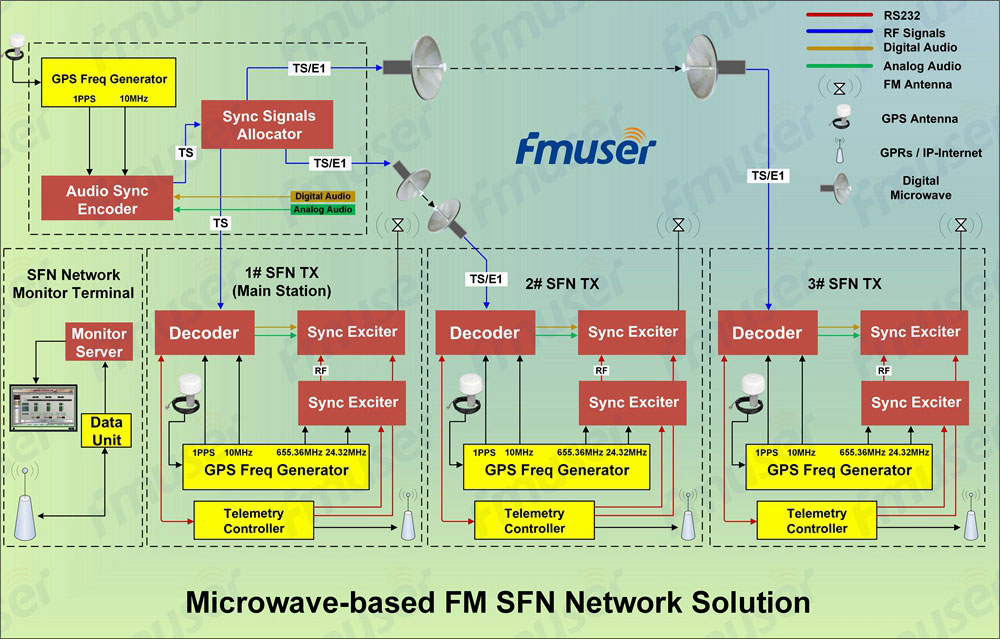
What are the advantages and disavantages of an FM Single-Frequency Network (SFN Network)?
Advantages of FM SFN Network (single-frequency network) are:
- Improved coverage: SFN networks provide improved coverage due to signals being broadcast from multiple locations, providing a stronger signal than a typical single-frequency network.
- Cost savings: SFN networks are typically less expensive to install and maintain than other types of networks.
- Simpler maintenance: SFN networks are easier to maintain due to the centralized control of the network.
Disadvantages of FM SFN Network (single-frequency network) are:
- Interference: SFN networks can be prone to interference from other signals and systems, resulting in poor signal quality and reduced coverage.
- Complex setup: SFN networks require a greater level of expertise and technical knowledge to set up and maintain, making them more difficult to install and configure.
- Limited range: SFN networks are limited in their range due to the reliance on multiple transmitters.
What are the applications of FM Single-Frequency Network (SFN Network)?
FM Single-Frequency Network (SFN Network) is a broadcast network architecture that uses a single frequency to transmit multiple transmitter signals to the same geographic area. This type of network has applications in radio and television broadcasting, mobile communications, public safety services, and more. SFN Networks are highly reliable, provide higher quality audio and video coverage, and are more cost-effective than other broadcasting methods. Additionally, they enable wider coverage with fewer transmitters, while also providing advantages such as improved interference immunity and reduced power consumption.
Why FM Single-Frequency Network (SFN Network) is important?
FM Single-Frequency Network (SFN Network) is important because it provides a cost-effective way to cover large areas with a single signal. It also improves the coverage quality of FM radio broadcasts, ensuring a more consistent listening experience. Additionally, SFN Networks help to reduce interference between multiple overlapping signals, leading to a higher quality of sound and fewer interruptions.
How to step-by-step build up a complete FM Single-Frequency Network (SFN Network) for FM radio broadcasting?
- Decide on the layout of the SFN network – this includes the number of transmitters, their locations, and their transmission parameters.
- Obtain the necessary licenses for the transmitters and configure each transmitter with the right parameters.
- Install the transmitters in the right locations and ensure that the antennas are properly configured.
- Connect the transmitters to the central transmitter to create a network of transmitters.
- Synchronize the transmitters to ensure that they are broadcasting the same signal at the same time.
- Test the SFN network to ensure that it is working properly.
- Monitor the SFN network to make sure that it is running smoothly.
- Make adjustments to the network as necessary to optimize its performance.
What equipment consist of a complete FM Single-Frequency Network (SFN Network)?
A complete FM Single-Frequency Network (SFN Network) consists of a transmitter, receivers, and a network controller. The transmitter sends out a signal on a single frequency, which is received by all the receivers. The network controller then synchronizes the receivers, so that all of them receive the same signal at the same time. This ensures that the audio is heard all at once, instead of being delayed or out of sync. The SFN Network also allows for better signal coverage, as the signal is able to reach a greater area than with multiple frequencies.
How to choose the best FM Single-Frequency Network (SFN Network)?
When choosing the best FM Single-Frequency Network (SFN Network) for FM radio broadcasting, it is important to consider the specific needs of the broadcaster, such as the geographical area to be covered, the desired signal strength, the available budget, and the technical requirements of the network. Additionally, it is important to research the experience of past customers to ensure that the chosen SFN Network meets the broadcaster’s expectations. Finally, it is important to consult with an experienced professional for advice on the best SFN Network for a broadcaster’s particular needs.
How to correctly maintain a FM Single-Frequency Network (SFN Network)?
As an engineer, you should ensure that the FM Single-Frequency Network (SFN Network) is regularly monitored and maintained according to the manufacturer's instructions. This includes routinely checking antenna alignment, verifying transmitter power levels, and ensuring that all components are functioning properly. Additionally, you should ensure that the network is regularly monitored for potential interference, and take steps to mitigate any interference that is detected. Finally, you should ensure that any changes made to the SFN Network are documented and shared with other engineers who might be responsible for its maintenance.
How to repair a FM Single-Frequency Network (SFN Network) if it fail working?
If an FM SFN Network fails to work, the first step is to check all the connections to the network to make sure that all the cables are properly connected. If the connections are good, the next step is to check the hardware components of the network, such as the antenna, power supply, and amplifiers, to make sure they are working properly. If the hardware components are working properly, the next step is to check the software components of the network, such as the encoder and modulator, to make sure they are properly configured. If the software components are not properly configured, it is important to follow the manufacturer's instructions to reset the settings. Depending on the problem, it may be necessary to update the firmware or software to the latest version. Once all the connections and components are checked and working properly, the final step is to test the network to make sure it is working as expected.
How to Choose the Base Station for SFN network?
- Considering Traffic: Make sure the the selected base stations can effectively cover the surrounding high-grade highways.
- Considering Population Density: Take into account the options that allows the coverage of densely populated areas such as cities or towns.
- Considering Add-ons: Add up extra coverage points in large cities with tall buildings surrounded.
- Considering Antenna Height: Keep the distance between the base stations within 31 miles if the station antenna height is set up at a low position; Keep the distance between the base stations within 62 miles if the station antenna height is set up at a high position.
How to Set up a Complete SFN Network?
- Plannng site survey and prepare for solutions
- Selecting the relevant equipment and quantity
- Positioning the central coherent area (AKA: the area of overlapping coverage) of the base station by testing the field strength.
In addition, the adjustment of the equalization time delay to the best sync state at the center of the coherent zone shall meet the following requirements:
- NO beating sound of the same frequency in the coherent area (monitoring when there is no audio signal)
- NO obvious modulation difference derived noise in the coherent area (clear voice and pleasant music)
- NO obvious phase difference distortion in the coherence zone (slight background noise)
- The subjective evaluation of the system synchronization effect reaches more than 4 points (except for the shaded area)
What are the technical requirements for FM SFN Network?
In order to seamlessly broadcast with a SFN Network, the interferences issues in the coherent area should be settled down once and for all, and here are 4 key factors that needs to be thouroughly considered, which are:
Guarantee Sufficient Field Strength
It is required that there is sufficient coverage field strength in all transmitting service areas in the system.
Co-Frequency
In the FM synchronous broadcasting system, the relative frequency difference between the carrier and the pilot frequency between any two adjacent transmitters is less than 1×10-9, the stability of the reference frequency source of each station ≤5×10-9/24 hours.
In-phase
In the FM synchronous broadcasting system, at the same reference point in the coherence zone, the relative time difference between the modulated signals transmitted by any two adjacent transmitters:
- Mono broadcast ≤ 10μS
- stereo broadcast ≤ 5μS.
In the FM synchronous broadcasting system, the phase delay stability of the modulated signal of each transmitter:
- Better than ±1μS (1KHZ, maximum frequency deviation: ±75KHZ, 24 hours).
Co-Modulation
- In the FM synchronous broadcasting system, the modulation degree error of any two adjacent transmitters is ≤3%
- In the FM synchronous broadcasting system, each transmitter is required to modulation stability ≤2.5% (1KHZ, maximum frequency deviation: ±75KHZ, 24 hours).
CONTACT US


FMUSER INTERNATIONAL GROUP LIMITED.
We are always providing our customers with reliable products and considerate services.
If you would like to keep touch with us directly, please go to contact us



